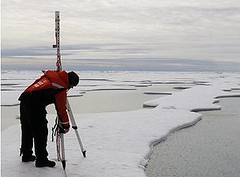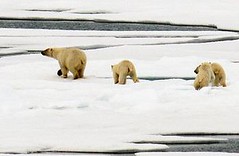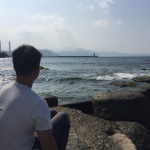 根據北極年終資料顯示,北極地區正進入有較暖和的空氣和水溫、減少的夏季海冰和雪量以及海洋化學物質的改變的狀態。北極熊和海象棲地雖減少但增加了鯨魚的捕食範圍讓北極擁有新的面貌。
根據北極年終資料顯示,北極地區正進入有較暖和的空氣和水溫、減少的夏季海冰和雪量以及海洋化學物質的改變的狀態。北極熊和海象棲地雖減少但增加了鯨魚的捕食範圍讓北極擁有新的面貌。
美國國家海洋暨大氣總署(NOAA)的《2012北極年終報告書》(Arctic Report Card)是由來自14國的科學家組成的國際團隊在1日所公布的。
NOAA海洋及大氣商業秘書處副主委麥地那(Monica Medina)表示,「由121位來自全世界的科學家共同完成的報告書中談到北極持續變暖、海冰減少及大量綠色植被出現。」她接著指出,「隨著更綠且更溫暖的北極出現,更多開發也很有可能隨之而至。就像這份報告一樣,幫助我們對未來北極資源索求的增加做好事前準備工作,所以我們可做更好的決定來處理保護這些更有價值,取得數量也不斷增加的資源。」
這份報告紀錄北極大氣、海冰、生物、海洋、陸地和格林蘭島。今年新增加包括溫室氣體、臭氧層和紫外線以及海洋酸化、北極海的主要生產和湖冰方面的紀錄。
2011年北極海大部分的近地面氣溫大約攝氏1.5度,遠超過1981-2010年的基線期。地面氣溫也超過以往基準。科學家說到,北極將持續長達十年似中緯度地區溫度的暖化程度。
 參與大氣方面年終報告書的NOAA西雅圖太平洋海洋環境實驗室談到:「北極的狀況源自於北極冷氣團南下到達東邊的北美和北歐,副極地暖氣北上進入西邊格陵蘭和東亞。」
參與大氣方面年終報告書的NOAA西雅圖太平洋海洋環境實驗室談到:「北極的狀況源自於北極冷氣團南下到達東邊的北美和北歐,副極地暖氣北上進入西邊格陵蘭和東亞。」
可能導因於最近的風向改變,2011年5月北極平流層的臭氧濃度是1975年有紀錄以來最稀薄的。
詹姆士(James Overland)談到:「雖全球因人類產生的溫室氣體排放正增加中,但沒有直接證據顯示北極的甲烷排放量有所改變。」
衛星拍攝2011年9月份最少量的北極海冰,是1979年以來第二量低的。
 協助年終報告書關於水文及陸地冰凍圈方面研究的紐約市立大學的馬克特德斯科(Marco Tedesco)談到,「科學家用文件資料一致且普遍地證明冰帽、冰河、雪量、冰原、永久凍土、湖冰、河流流量和河流生物地球化學正持續改變中。」
協助年終報告書關於水文及陸地冰凍圈方面研究的紐約市立大學的馬克特德斯科(Marco Tedesco)談到,「科學家用文件資料一致且普遍地證明冰帽、冰河、雪量、冰原、永久凍土、湖冰、河流流量和河流生物地球化學正持續改變中。」
2010至2011年間,在格陵蘭的冰原和北極大部分的冰河和冰帽狀況呈現負面極大失衡。也就是更多的冰和雪融化移動量大於降雪量。特德斯科說:「特別是格陵蘭西坡冰原經歷巨大的融化現象。」
他說:「從1970年代便已持續下降的降雪程度到2011年春已低於平均水準,並自2006年開始加速減少中。6月歐亞大陸的降雪量是1966年衛星記錄以來最低的。東部的加拿大北極地區受氣溫影響變化甚大的湖冰持續時間,2010至2011年和1997至2010年相比縮短近達4到5個禮拜。」
2010年流進北冰洋的河流流量接近長時期(1936年至2009年間)六大歐亞北極河流流量,和4大北美北極河流量的平均值。
根據報告,海水一段時期的暖化或淡化後,北冰洋的氣溫和鹽度也許會漸趨穩定平衡。已有證據顯示博福特(Beaufort)和楚科奇海(Chukchi seas)吸收二氧化碳造成海水的酸化。
位於麻薩諸塞州的霍爾海洋科學研究所(Woods Hole Oceanographic Institution in Massachusetts),其參與年終報告海冰和海洋部分的研究人員安德魯(Andrey Proshutinsky)指出,和1948到1996年典型順時針循環風向5至8年後轉為逆時針風向不同,北冰洋目前的風向為長達至少14年的順時針循環。
結果造成海冰覆蓋面積比1979到2000平均值低至少百分之15至20。
安德魯表示,古老且厚的多年期冰(至少經過兩個夏季而未融盡的海冰)已隨著總海冰面積的減少也一起消失了,這是史無前例的。由融化的海冰所釋出的額外淡水已經注入北冰洋北端。海冰的消失已造成北極較北端的海水暖化和擴張而導致一定程度的海平面上升。
陸地上凍原植被繼續增加也跟北極大多數陸地氣溫已偏高相關連。
 北極野生凍原生物質產量的增加所造成的衝擊還情況不明。常在貧瘠土地上作遷徙的北美馴鹿為顯著的自然變異例證之一,許多經歷十年樹數目減少的生物群開始增加或維持現有數量。
北極野生凍原生物質產量的增加所造成的衝擊還情況不明。常在貧瘠土地上作遷徙的北美馴鹿為顯著的自然變異例證之一,許多經歷十年樹數目減少的生物群開始增加或維持現有數量。
年終報告中協助陸地研究部分的阿拉斯加費班克大學(University of Alaska Fairbanks)史基沃克(Skip Walker)和加拿大野生動物局(Canadian Wildlife Service)麥克吉兒(Mike Gill)都指出,儘管這樣,我們需關注北極地區快速的環境變化和社會變遷。吉兒也主導由北極委員會動植物保育工作小組執行的極地周圍的生物多樣性監控計劃(Circumpolar Biodiversity Monitoring Program)。
2010年對北極生物多樣性評估報告中指出,在北極高緯度地區物種數目減少百分之26。北極物種趨勢指數(Arctic Species Trend Index)第一篇報告中顯示北極旅鼠、北美馴鹿和紅腹濱鷸的數目在過去34年都呈現下降趨勢。
沃克和吉兒撰寫的長期實際地面觀察報告中顯示,因土石流和其他侵蝕作用所導致綠化的逐漸擴大,和北極地區逐步暖化的凍土層、苔原上的火災以及人類足跡的增多息息相關。
The Arctic is entering a new state with warmer air and water temperatures, less summer sea ice and snow cover, and changed ocean chemistry, finds the annual Arctic Report Card. Less habitat for polar bears and walruses but increased access to feeding areas for whales characterizes the new Arctic pattern.
The 2012 Arctic Report Card was prepared by an international team of scientists from 14 different countries and issued today by the National Oceanic and Atmospheric Administration, NOAA.
"This report, by a team of 121 scientists from around the globe, concludes that the Arctic region continues to warm, with less sea ice and greater green vegetation," said Monica Medina, NOAA principal deputy under secretary of commerce for oceans and atmosphere.
"With a greener and warmer Arctic, more development is likely," Medina said. "Reports like this one help us to prepare for increasing demands on Arctic resources so that better decisions can be made about how to manage and protect these more valuable and increasingly available resources."
The Report Card tracks the Arctic atmosphere, sea ice, biology, ocean, land, and Greenland. This year, new sections were added, including greenhouse gases, ozone and ultraviolet radiation, ocean acidification, Arctic Ocean primary productivity, and lake ice.
In 2011, the near-surface air temperatures over much of the ocean were approximately +1.5 degrees Celsius greater than the 1981-2010 baseline period. Land temperatures also topped their baseline values. This continued a decade-long warming of the Arctic relative to mid-latitudes, the scientists report.
"This pattern is responsible for sending cold air from the Arctic southward into eastern North America and northern Europe, and warm air from the sub-Arctic northward into western Greenland and east Asia," says James Overland of NOAA's Pacific Marine Environmental Laboratory in Seattle, who coordinated the atmosphere section of the report card.
Possibly linked to recent changes in wind patterns, ozone concentrations in the Arctic stratosphere during March 2011 were the lowest ever recorded during the period beginning in 1979.
"While the global increase of human sources of greenhouse gases continues, there is no direct evidence that Arctic emissions of methane are changing," says Overland.
The minimum Arctic sea ice area in September 2011 was the second lowest recorded by satellite since 1979.
Marco Tedesco, of the City College of New York, who coordinated the hydrology and terrestrial cryosphere section of the report card, said the scientists documented "consistent and widespread evidence for continuing change in snow cover, glaciers and ice caps, the Greenland ice sheet, permafrost, lake ice, river discharge and river biogeochemistry."
On the Greenland ice sheet and on most glaciers and ice caps elsewhere in the Arctic, the period 2010-2011 was characterized by a negative mass balance. That is, more snow and ice was lost to surface melting and runoff than snow was gained. "The western slope of the Greenland ice sheet in particular experienced a significant increase in surface melting," Tedesco said.
Below-average snow extent during spring 2011 is consistent with a decline observed since the 1970s, and continues an accelerated decrease since 2006, he said. June snow cover extent in Eurasia was the lowest since the start of the satellite record in 1966.
Lake ice cover duration, largely influenced by air temperature changes, was shorter by as much as four to five weeks in 2010-2011 compared to the 1997-2010 average for the eastern Canadian Arctic, said Tedesco.
River discharge into the Arctic Ocean during 2010 was close to the long-term (1936-2009) mean for the six largest Eurasian Arctic rivers and the four large North American Arctic rivers.
Arctic Ocean temperature and salinity may be stabilizing after a period of warming and freshening, according to the report. Acidification of the sea water as a result of carbon dioxide absorption has been documented in the Beaufort and Chukchi seas.
Andrey Proshutinsky, of the Woods Hole Oceanographic Institution in Massachusetts, who coordinated the sea ice and ocean section of the report card, points to a clockwise wind-driven circulation regime that has dominated the Arctic Ocean for at least 14 years, in contrast to the typical five to eight year pattern of clockwise-counterclockwise circulation shifts observed from 1948-1996.
As a result the sea ice cover has been at least 15-20 percent below the 1979-2000 average.
The decline in total sea ice extent has been accompanied by an unprecedented loss of old, thick multiyear ice, Proshutinsky says. Melting sea ice has released additional fresh water into the upper ocean. The loss of sea ice also has resulted in the warming of the upper ocean and ocean expansion, leading to an increase in the rate of sea level rise.
And on land, Arctic tundra vegetation continues to increase and is associated with higher air temperatures over most of the Arctic land mass.
The impacts of this increased tundra biomass production on Arctic wildlife are unclear. Migratory barren-ground caribou appear to be within known ranges of natural variation, with many herds that have experienced declines in the past decade beginning to increase or stabilize.
Despite this, rapid environmental and social changes in the Arctic are a concern, say terrestrial section coordinators Skip Walker of the University of Alaska Fairbanks, and Mike Gill of the Canadian Wildlife Service. Gill also chairs the Circumpolar Biodiversity Monitoring Program implemented by the Conservation of Arctic Flora and Fauna Working Group of the Arctic Council.
A 2010 assessment of the Arctic's biodiversity reported a 26 percent decline in species populations in the High Arctic. The first report from the Arctic Species Trend Index showed that populations of lemmings, caribou and red knot experienced declines over the previous 34 years.
Walker and Gill write that long-term ground-based observations show widespread greening occurring due to landslides and other erosion features related to warming permafrost, tundra fires and increased human presence in the Arctic.








